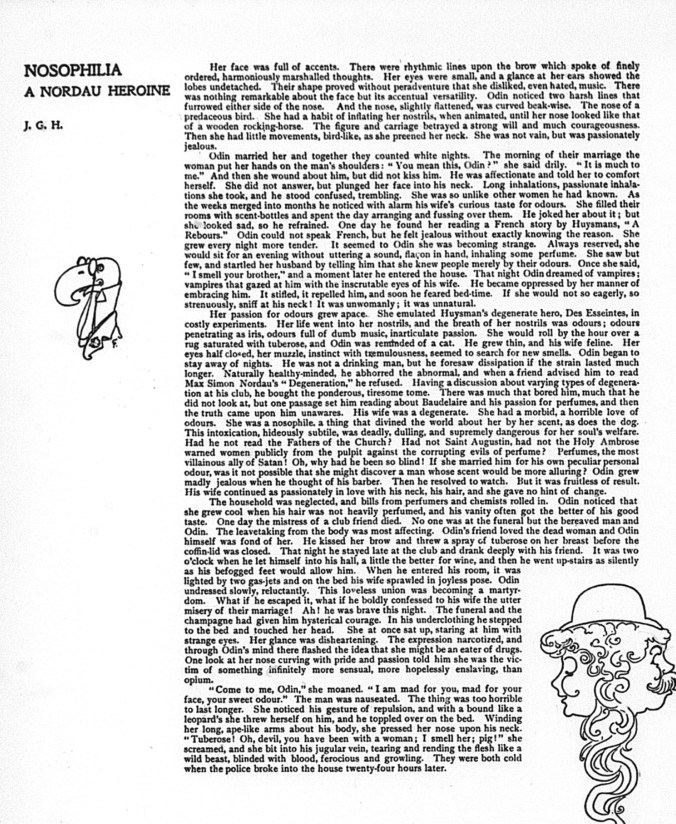Nicolette Gable

Published fortnightly in New York from 1895 to 1898, M’lle New York was a “little” magazine, a periodical dedicated to current high art and literature. In this short story from M’lle, we find engagement with and mockery of physiognomic and degenerative theories of sexuality, a description of strange and ultimately fatal perversity, and commentary on the relationship between art and sexuality. This breadth of references suggests that discussions of sexuality, even “deviant” sexuality, were visible and vibrant within artistic and literary communities, even in an era of censorship.
“Nosophilia: A Nordau Heroine,” by James Huneker, appeared in the October 1895 issue of M’lle. In this story, Huneker satirizes the ideas of Max Nordau, an Austrian doctor and follower of criminologist Cesare Lombroso, who viewed degenerative art and degenerative sexuality as intertwined. Huneker’s story draws from various theories of sexuality, imitating and exaggerating the hysterical prognostications of doom that surrounded such discussions of non-normative sexuality and popular culture at the turn of the century.
Huneker’s short story describes the degenerative journey of Nosophilia and her husband Odin. The story underscores Odin’s alarm when he discovers her obsession with odors and the fact that Nosophilia is reading J. K. Huysmans’ À Rebours, a novel about the strange, eccentric, and perverse sensual and aesthetic obsessions of an aristocrat. Seeking advice on how to treat Nosophilia, the husband turns to Max Nordau’s Degeneration, which contained extensive descriptions and categorizations of various perversities. In it Nordau argued that degenerate art and literature was both the result and the cause of physical degeneration, which itself could be spread by exposure to corrupted art. Degeneration took America by storm in 1895 when it was translated into English. Among the categories appearing in this tome was “nosophilia,” defined by Nordau as the pathological love of illness. Though Huneker playfully redefines the term to denote an obsession with smells, his story questions Nordau’s and his audience’s obsession with illness and the trajectory of the story mocks the degenerative narratives that characterize Nordau’s writing.
The existence of this piece in 1890s New York is notable because the New York Society for the Suppression of Vice—led by Anthony Comstock to enforce the Comstock Laws—had as its mission to prevent the circulation of obscene and lewd materials and heavily surveilled printed matter in this period. In practice this meant the repression of any kind of sexual knowledge that offended Comstock’s moral vision. M’lle New York reminds us that such knowledge did circulate, that there existed vibrant print discussions of sexuality in the age of Comstock. Huneker assumes, for example, that his audience will be familiar with recent risqué French literature, with theories of degeneration, with the idea of sexual fetishes in general, and with the specific theories of an Austrian physician. “Nosophilia,” then, is an archival trace of a vibrant sexual language in an era of censorship.
 Nicolette Gable is a PhD Candidate in American Studies at The College of William and Mary. She is working on her dissertation on the Decadent movement in America in the 1890s. Her research interests center around the intersection of knowledge and sexuality and includes the history of sexuality, the history of science, and cultural theory.
Nicolette Gable is a PhD Candidate in American Studies at The College of William and Mary. She is working on her dissertation on the Decadent movement in America in the 1890s. Her research interests center around the intersection of knowledge and sexuality and includes the history of sexuality, the history of science, and cultural theory.

NOTCHES: (re)marks on the history of sexuality is licensed under a Creative Commons Attribution-NonCommercial-NoDerivatives 4.0 International License.
Based on a work at www.notchesblog.com.
For permission to publish any NOTCHES post in whole or in part please contact the editors at NotchesBlog@gmail.com




